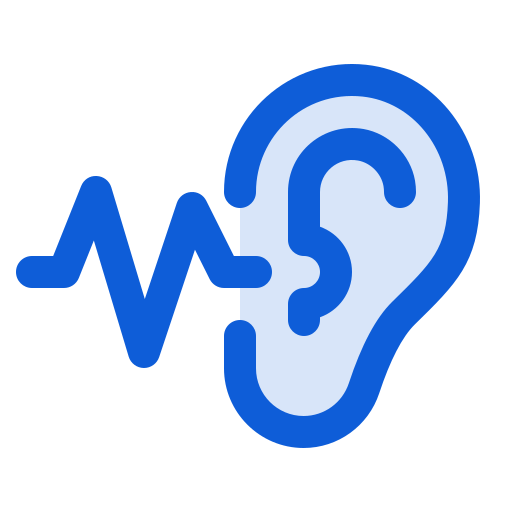Contents

Behavioral observation assessment (BOA)
BOA testing is conducted by an audiologist specially trained to detect bodily reactions to sound i.e. cessation of activity, body movement, eye widening, eye opening, or change in sucking rate
Visual reinforcement audiometry (VRA)
As children mature, so does their ability to respond to sound. At approximately six to seven months of age, normally-developing children are able to turn toward a sound source. Children at this level are tested either using earphones or in the sound booth without earphones but using speakers. Sounds used for testing typically include low pitch to high pitch tones that are included in the speech range. Turning toward the sound source is reinforced with a lighted toy. This type of testing is called visual reinforcement audiometry (VRA) and is generally quite accurate in determining hearing levels.
Conditioned play audiometry
By approximately 2 1/2 – 3 years of age, most children can be tested using a technique called conditioned play audiometry. Earphones are placed on the child and she/he is conditioned to play various games when the test tone is heard.
Pure Tone Audiometry
It involves carefully listening through headphones that are placed over the ears or inserting earphones that are placed in the ear canals. The patient will be asked to listen for tones or beeps that vary in pitch and loudness and instructed to press a button when they hear the tones. The tones will be presented through the headphones and/or insert earphones, as well as through a bone conduction vibrator on a headband that is placed behind the ear. By completing the basic tests that have been described, both the type and degree of hearing loss that the patient may have can be determined test hearing.
Speech Audiometry
Speech audiometry has become a fundamental tool in hearing loss assessment. In conjunction with pure-tone audiometry, it can aid in determining the degree and type of hearing loss. Speech audiometry also provides information regarding discomfort or tolerance to speech stimuli and information on word recognition abilities.
Immittance test hearing
Acoustic immittance testing evaluates the eardrum and the middle ear space behind the eardrum, as well as a muscle reflex that involves the eardrum and middle ear, the inner ear, the auditory nerve, the auditory brainstem pathways and the facial nerve. Acoustic immittance testing helps to localize what part of the ear may be involved in the cause of hearing loss.
OAE’s
The OAE test is used to find out how well your inner ear, or cochlea, works. It measures otoacoustic emissions or OAEs. These are sounds given off by the inner ear when responding to a sound. There are hair cells in the inner ear respond to sound by vibrating. The vibration produces a very quiet sound that echoes back into the middle ear. This sound is the OAE that is measured.
ABR
The auditory brainstem response (ABR) test tells us how the inner ear, called the cochlea, and the brain pathways for hearing are working. You may also hear it called an auditory evoked potential (AEP). The test is used with children or others who cannot complete a typical hearing screening. The ABR is also used if your symptoms might be due to hearing loss in the brain or in a brain pathway.
ASSR
The auditory steady-state response (ASSR) can be thought of as an electrophysiologic response to rapid auditory stimuli. The goal of ASSR is to create an estimated audiogram from which questions regarding hearing, hearing loss, and aural rehabilitation can be answered. ASSR allows the hearing care professional to create statistically valid audiograms for those unable or unwilling to participate in traditional behavioral tests. ASSR relies on statistical measures to determine if and when a threshold is present.
Electrocochleography (ECochG)
Electrocochleography (ECochG) is another test that measures electrical activity that occurs in response to sound. During ECochG testing, electrical activity that is generated in the hearing portion of the inner ear called the cochlea is measured. Electrical activity from the hearing nerve is also recorded. the patient can sleep during the test session. Changes in the electrical activity recorded from the cochlea may aid in the diagnosis of inner ear disorders, such as Meniere’s disease, perilymphatic fistula, and semicircular canal dehiscence.
Tinnitus Management
Tinnitus is when you experience ringing or other noises in one or both of your ears. The noise you hear when you have tinnitus isn’t caused by an external sound, and other people usually can’t hear it. Tinnitus is a common problem. It affects about 15% to 20% of people and is especially common in older adults. Tinnitus is usually caused by an underlying condition, such as age-related hearing loss, an ear injury, or a problem with the circulatory system. Visit Meenakshi Hearing Aid Center for Tinnitus Treatment.
Symptoms
- Buzzing
- Roaring
- Clicking
- Hissing
- Humming
Tinnitus Treatment:
1. Underlying Conditions:
- Earwax removal clearing earwax blockages can alleviate symptoms.
- Blood Vessel Treatment: Medication, surgery, or other interventions for vascular conditions.
- Hearing Aids: Beneficial for tinnitus related to noise or age-related hearing loss.
- Medication Changes: Reducing, stopping, or switching medications that cause tinnitus.
2. Electronic Devices:
- White Noise Machines: Produce soothing sounds to mask tinnitus, useful at night.
- Masking Devices: Ear-worn devices emitting continuous low-level noise.
3. Behavioral Therapies:
- Tinnitus Retraining Therapy (TRT): Combines sound masking and counselling for symptom management.
- Cognitive Behavioral Therapy (CBT): Techniques from a mental health professional to reduce anxiety and depression related to tinnitus.

